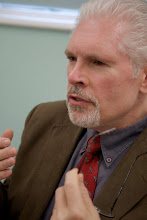By: Monica Hernandez
When I went to see The Veil directed by Conor McPherson at the National Theatre on Halloween night, I thought I was going to be promised apparitions on stage accompanied by a thrilling story. Unfortunately I was given neither. The play which takes place in 1822 and focuses on an aristocratic family living in a crumbling mansion in rural Ireland mostly consists of dialogue rather than action. Furthermore the financial and otherworldly tribulations that the wealthy Lambroke family faces seem to pale in comparison to the problems experienced by Ireland’s poor and starving population. This only further alienates the audience from the family making it easier to not care about the main characters and the situations they go through.
 |
| Emily Taaffe (Hannah Lambroke) and Jim Norton (Reverend Berkeley) |
The Veil seems to question if the spirits in the play are actually real or if they are merely dreamt up by the characters. Indeed they could symbolize the degradation of the aristocracy not only morally, but also mentally. Grandie for instance is rarely in a lucid state of mind and constantly speaks of things, such as the ghostly dog, that seem to make no sense. Hannah also claims to hear voices while her father who hung himself apparently suffered from some sort of mental illness. The idea then that Hannah could have inherited an illness from her family serves as a possible explanation for her visions. Another reason for Hannah’s hallucinations is presented when she starts taking laudanum offered to her by Berkeley’s traveling companion Charles Audelle (Adrian Schiller) who is already addicted to it. Yet the fact that the audience is never given a definite answer about if the spirits are real or not keeps open the possibilities that there may be spiritual forces at work which in turn leaves the audience in a state of suspense, but also in a state of confusion.
It must be noted that the cast in The Veil all deliver fine performances. Ursula Jones’ Grandie in particular provides both a source of comic relief, such as in the scene where she walks faster after being promised cake, as well as a sense of eeriness. Emily Taaffe also does a splendid job of performing the troubled Hannah while Fenella Woolgar is equally strong as Hannah’s stern mother. Yet faced with a plot that does little to develop the characters or cause the audience to really sympathize with them, even these strong performances are powerless in making the play more enriching. The most that the actors can do is to create a few comedic and unsettling scenes that serve at best to drag the audience along.
 |
| Ursula Jones (Grandie), Jim Norton (Reverend Berkeley), Emily Taaffe (Hannah Lambroke), and Adrian Schiller (Charles Audelle) |
Thus the highlight of The Veil has nothing to do with ghosts or fear, but instead is the spectacular set design and lighting. Rae Smith’s recreation of the mansion is done with such amazing detail that it is hard to believe that it is just a set piece rather than an actual building. Each prop from the mirror where the patriarch of the family hung himself to the piano and the chairs seems specifically and meticulously placed and brings the set to life. The inclusion of the stairs and the foyer as well as the back garden also transforms the stage into a realistic and aesthetically pleasing setting. Another amazing feature of the play is Neil Austin’s lighting which changes to reflect both day and night. It beautifully showcases the mansion and the garden and aids in creating different moods throughout the show.
Hence, in the end The Veil is more of a technological rather than theatrical masterpiece. If anyone deserved to have thunderous applause that night it would have been set designer Rae Smith, lighting designer Neil Austin, and sound designer Paul Arditti. However, it should be mentioned that my youth may have affected my view towards the play since I did notice that most of the audience members were middle-aged or older. Indeed it does seem logical that someone from a younger generation may have less patience with long amounts of dialogue and consequently yearn for more action. Thus The Veil may be better suited for older audience members.

No comments:
Post a Comment